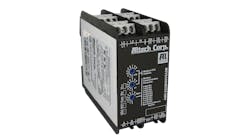How to protect networks against transient spikes
It was a dark and stormy night. The team was safely inside the plant running production when, suddenly, lightning strikes—a transient spike on our automation network communication cables.
Three network switches, two programmable-logic-controller (PLC) central processing units (CPUs) and two PLC analog input cards fell silent, all victims of the burst of voltage on their connections.
Get your subscription to Control Design’s daily newsletter.
This is not a nightmare. This is what may happen if your operational-technology (OT) or automation network is not properly protected—not from nefarious hacking intruders dressed in dark hoodies, but from the sudden release of electrical energy of the storm outside.
Operational-technology networking connects the hardware that monitors or controls devices and processes in an industrial plant. This hardware can be connected in different ways, but it is most often some form of Ethernet, such as Profinet, Modbus or Common Industrial Protocol (CIP). The advantage of Ethernet-based systems is the commonality of cables, routers and switches that are used in the information-technology (IT) infrastructure, although OT-specific hardware may be ruggedized to work in a more severe industrial environment.
There is a lot of information available to help protect your OT network in regard to cybersecurity and hacking, but how do you protect against transient spikes?
Transient spikes are very short bursts of voltages that can range from a few Volts to thousands of Volts induced on a signal cable. These last only a few milliseconds but can damage circuits and components. Communication cables and analog signal cables are vulnerable.
Earth ground
There are several methods to discharge or dissipate transients. Most Ethernet switches have transient protection built in, but this protection relies on a proper path to Earth ground.
On an automation network, the most basic form of protection is to start by providing an Earth ground to the network switches. If the ground is not connected, the device is not protected. Ensure that all network switches are Earth grounded.
Transient suppressors
A second form of protection for the network data lines is to install data line transient suppressors. These are normally devices that are mounted and grounded in the cabinet near the network switch or other network device. The suppressors are placed in series with the network cable via onboard network-in and network-out connections. They may use a high-capacity gas discharge tube, clamping diodes, metal oxide varistors (MOVs) or a combination of these devices to dissipate the voltage spike and prevent damage to connected equipment.
Device methods and recommended uses
A gas discharge tube (GDT) consists of a gas mixture in a sealed glass tube, placed between two electrodes. When a high-voltage spike is realized across the device, the gas becomes ionized. This ionized gas provides a controlled discharge of the spike. Given their small size, they can handle a surprisingly large amount of current. These are typically used on higher-frequency signal lines, so they work well for protection of network data cables and systems.
Clamping diodes, specifically Zener diodes, are utilized to limit voltage levels. These are particularly useful for analog signal levels such as 4-20 mA signal levels used for control or instrumentation. Two 47-V Zener diodes connected cathode-to-cathode and placed across the signal and common of a PLC analog input module will protect the module and any connected devices from transient spikes. Zener diodes have a specified breakdown voltage (Vz) and the voltage across the line is “clamped” to this level.
A common method for Ethernet transient protection is a transient-voltage-suppression (TVS) array. These devices are usually an array of both standard and Zener diodes, which shunt the current to ground to protect data ports. A normal Ethernet signal is just under 2 V. A TVS with a clamping voltage of at least 2.5 V is necessary.
Metal oxide varistors also protect against transient voltages. The resistance of the MOV varies with the voltage. When the voltage applied is less than the device’s rated voltage, the MOV has essentially infinite resistance. When the rated voltage is exceeded, this resistance drops to zero. The transient current then passes through the MOV instead of through the protected device. MOVs are typically used in addition to gas discharge tubes to protect network components. For transient protection, an MOV is more likely to be used across a power supply.
There are several devices available that can be placed in-line to help protect a physical network. The cost and the methods of suppression will vary. Devices that use a combination of the components previously listed will be more robust but at a higher cost.
A small amount of research will help to find a proper solution for your particular network. A failure of a physical network component may not have consequences as serious as the network being hacked, but it can be costly in terms of machine downtime or failure to capture critical data. Lightning may not wear a hoodie, but it can be dangerous to the network just the same.





